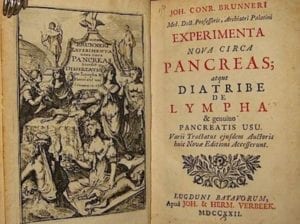In the history of medicine, the Swiss anatomist and physician Johann Conrad Brunner is more often remembered for discovering the glands in the duodenal mucosa than for his experiments on the pancreas. Though able to surgically induce at least transient diabetes mellitus in dogs, he failed to make a connection between the pancreas and diabetes, and this was not made until some two hundred years later by von Mering and Minkowski (1889).
Brunner was born in 1653 in a small Swiss town on the Rhine at the border with Germany. His parents recognized his talent and sent him at age sixteen in 1669 to study medicine in Strasbourg. He graduated there after four years, (1673), and then went to Paris to study under the most famous anatomist of the time, Du Verney. There Brunner proved so diligent that he was asked to stay, but decided instead to continue his studies in England and in the Netherlands. In 1675 he returned to Strasbourg and at age twenty-two obtained his doctorate. He then returned to his native town, where he settled down as a family physician.
There was at the time very little known about the function of the pancreas, and Brunner’s interests in that subject had begun during his stay in Paris. With the help of local surgeons he began trying to remove the pancreas or ligate its main duct, but was unable to remove the part of the pancreas adhering to the duodenum so that, in effect, he carried out only partial pancreatectomies. This work he continued after his return to Switzerland, operating over time on eight dogs and noting in some increased appetite, urination, and thirst. This work was not without its difficulties. His neighbor’s hunting dog ran away two days after surgery, and when he came back his owner refused to return him to the experimenting physician. Another dog also ran away, and in some dogs the operation produced no detectable effects. Nevertheless, by 1683 Brunner was able to report his observations in Amsterdam in a publication titled Experimenta nova pancreas (New experiments on the pancreas).
In 1686 Brunner was invited to become professor of anatomy and physiology at the University of Heidelberg. It was the 300th anniversary of the creation of the University, and Brunner applied himself to organize the teaching of anatomy, obtain enough cadavers for dissection, and establish a chemistry laboratory. He was popular with his colleagues and with the students. In 1687 he described the glands the duodenum, which he thought produced a secretion just as the pancreas did. Later he became the first to describe syringomyelia, and he also became the Court physician to a succession of elector-princes of the Palatinate.
In 1688 war broke out between France and the Holy Roman Empire. French troops occupied Heidelberg causing massive destruction, and for some time all research came to an end. Following further destruction in 1693, the University was moved from Heidelberg, at first to Frankfurt. Brunner’s life remained closely tied to the prince electors of the Palatinate, who supported his research, appointed him dean of the University, and by whom he was knighted. He remained their personal physician, and in 1720 followed the Court of the Palatinate when it moved to Mannheim. Suffering from kidney stones and later also from gout, he became convinced in 1723, at age seventy. of the benefits of a milk diet. To this he submitted himself as well as his patients, taking a pint for breakfast, another pint with white bread for lunch, another pint at dinner, and half a pint before bed. He found it greatly improved his well-being, appetite, and digestion, and even his hemorrhoids, sleep, as well as slowing his pulse. Among his other medical activities, he recommended venesection for heart diseases, inoculation to prevent smallpox, and paracentesis for ascites. He died in 1727, more remembered for the Brunner’s glands in the duodenum than for his pioneering work on the pancreas and diabetes.

Further reading
- Kuthmann E. Johann Conrad in Heidelberg as teacher and physician (in German). Swiss journal of history of medicine and sciences 1957;14:no14.
- Zimmermann OC. Johann Conrad Brunner1653-1723. Diabetes 1957; 6(6): 537 (Nov).
- Bosmia AN, Tubbs RI, Clapp DC et al., Johann Conrad Brunner (1653-1727) and the first description of syringomyelia. Childs Nerv Syst. 2014:;30(2):193 (Feb).

Leave a Reply